Matador Network's Blog, page 1041
August 5, 2019
How to island hop through Scotland

The bulk of travelers to Scotland tend to focus their energy on a pretty narrow segment of what the country actually has to offer. You can easily spend a few weeks exploring the cobbled streets of Edinburgh, shopping in Glasgow, visiting castles in the Highlands, and working up the courage to try blood pudding, but there’s more to Scotland than the mainland. For a truly unique Scottish adventure, you have to check out the islands. From the Isle of Arran just west of Glasgow to the Island of Lewis and Harris in the far north, these islands will show you a side of Scotland you never knew existed. Here’s how to plan your epic island-hopping adventure.
1. Isle of Arran
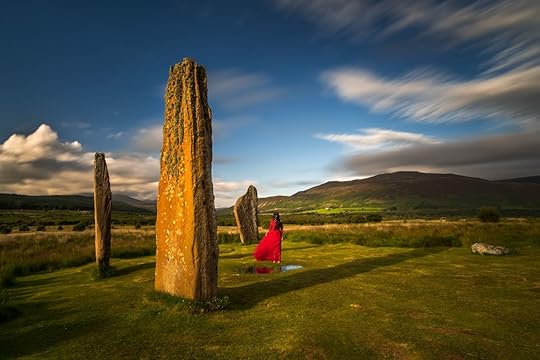
Photo: Swen Stroop/Shutterstock
The best way to conveniently hit as many Scottish islands as possible is by starting from the south and working your way up. This means beginning your journey at Ardrossan Harbour, just under an hour’s drive west from Glasgow. The crossing is served by the MV Caledonian Isles ferry, which you’re welcome to board with either a vehicle or as a passenger on foot. In under an hour, the ferry brings you to Brodick, the main town on the Isle of Arran, and it’s the perfect base from which to explore the incredibly diverse landscape.
Brodick Castle is a good place to start. Just a 10-minute drive north of town, the castle has stood since 1510 and was previously the home of the Dukes of Hamilton. Now, you can wander the grounds and explore its waterfalls, woods, and walled garden. Continuing your northward journey from Brodick, outdoor enthusiasts should be sure to check out Goat Fell, the island’s highest point at 2,866 feet. This rugged mountain is replete with jagged ridges and summits offering spectacular views of both the sea and the rest of the island. And if you’re really adventurous, you can take the Arran Coastal Way, a self-guided hiking trail that starts in Brodick and stretches across the island’s entire coastline.
You can’t leave Arran without visiting the Machrie Moor standing stones, perhaps the island’s most famous feature. Located on the western edge of the island, yet still only 20 minutes from Brodick, the circles are a collection of six ancient stone circles dating back to 3,500 BC. Think Stonehenge, but without hundreds of tourists clamoring for the same exact sunset photo.
2. Islay

Photo: Rebecca Schochenmaier/Shutterstock
Islay is an island north of Arran famous for its whisky — it’s known as “whisky island” — and there are a few ways to get there. You can drive west from Glasgow to Kennacraig, where you can catch a ferry to Islay, but if you’re coming from Arran, take a ferry from the northern town of Lochranza to Claonaig, drive from Claonaig to Kennecraig, and then take the ferry to Port Askaig on Islay. It might sound like a hassle, but it’ll give you the chance to get intimately acquainted with Scotland’s ferry system, as well as some pretty remote roads few tourists ever travel.
Saying that Islay has some of the best beaches in Scotland might not sound like a towering achievement, but the island does have some beautiful stretches of white sand. A 25-minute drive from the town of Bowmore, Kilchoman Beach is a perfect place to watch the sunset over the Atlantic. There’s also the smaller Saligo Bay, Kintra Beach, and the east-facing Kilnaughton Beach if you’re an early riser.
Islay may only have 3,000 residents, but they take their whisky seriously. There are a total of nine working distilleries on the island, with the first founded in 1779. The nine are spread all across the island, but if you’re trying to visit as many as you can in a short period of time, your best bet is heading to the south coast. The Ardbeg, Lagavulin, and Laphroaig distilleries are right next to each other, and easily accessible from Port Ellen. All of the island’s distilleries offer tours, so you can sample the best of “whisky island” no matter which distillery you choose to visit.
3. Isle of Mull
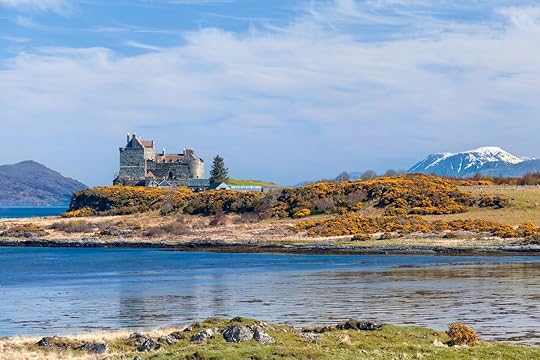
Photo: Spumador/Shutterstock
The Isle of Mull is one of Scotland’s most famous islands, and the easiest way to get there is by ferry from Oban, which only takes 45 minutes. There is no direct ferry from Islay to Mull, so your island-hopping will have to take a brief detour through the mainland before continuing your journey north. Once you’re there, though, you’ll see that it was worth the effort. With beaches, castles, distilleries, 300 miles of coastline, and plenty of history, Mull is one of the most diverse islands in the UK.
You’ll want to start exploring Mull from the town of Tobermory, which is known for its painted houses along the waterfront. Take the Bruce Trail along the Niagara Escarpment. It stretches pretty far along the coast, but it’s perfect for getting acquainted with the island and its natural scenery. And if you didn’t get enough whisky on Islay, you can head to the Tobermory Distillery, dating back to 1798, before venturing out to explore the rest of the island.
Duart Castle, about 45 minutes west of Tobermory, is the most dramatic castle on Mull. Built around the 13th century, it’s perched on a promontory over the sea, and visitors can now take a tour of the property that includes the tearoom, which offers seasonal fare. You might even recognize the castle from movies like Entrapment, When Eight Bells Toll, and I Know Where I’m Going.
If you’ve traveled through the Highlands, you might think the only animals in Scotland are Highland ponies and sheep. A visit to Mull, however, will quickly show you the light. Mull is one of the best places in the UK for seeing otters and white-tailed sea eagles, as well as red deer, seals, and whales. It’s a premier destination for bird watchers, and there are several boat and walking tours led by local guides to ensure you don’t miss any of the island’s native wildlife.
Mull is also often used as a jumping off point for visiting Iona, a small island only a four-minute ferry ride away from Fionnphort. Famous for its abbey, where dozens of former Scottish, Norwegian, and Irish kings are buried, the small island makes a perfect day trip.
4. Isle of Skye
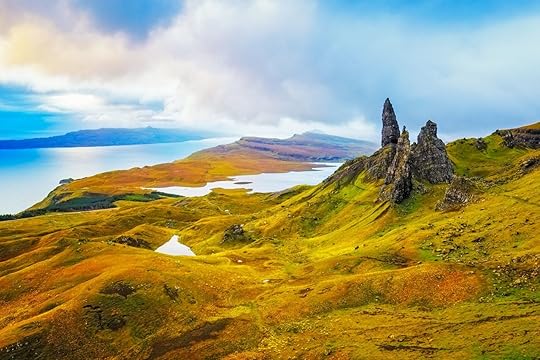
Photo: Lukasz Pajor/Shutterstock
Many believe that the Isle of Skye is Scotland’s most breathtaking destination, and not without reason. From ancient rock formations to sweeping ocean vistas and fairy tale-esque pools, Skye has it all. Getting there from Mull would require too many ferries and transfers to be feasible, so you should probably return to the mainland and take the scenic coastal route to Mallaig, where you can catch a ferry to Skye. You can also take the slightly longer route and eliminate ferries from the equation entirely, passing alongside Fort Augustus and Loch Ness before cutting back west toward Skye and crossing the Skye bridge.
Under an hour away from the bridge is Portree, the largest town on Skye, and if you’re spending a few days on Skye — as you definitely should — you’ll probably be using it as your base. The town is perfectly located for seeing everything the island has to offer. Just 13 minutes north of town, you can visit the Old Man of Storr, a set of jagged, iconic rock formations formed by an ancient landslide. If you’ve ever searched for pictures of Skye, it’s pretty much all about the Old Man of Storr. The full 2.3-mile hike through the area takes you past it and other rock formations, as well as over rolling green hills.
After you’ve spent some time exploring the rocks, head to the Fairy Pools, half an hour south of Portree. These magical pools at the foot of the Black Cuillins mountain range are famous for their mini-waterfalls and mystical character. There’s a 1.5-mile, 40-minute hike to access the pools, and you can even go swimming in them if you feel so inclined.
5. Lewis and Harris
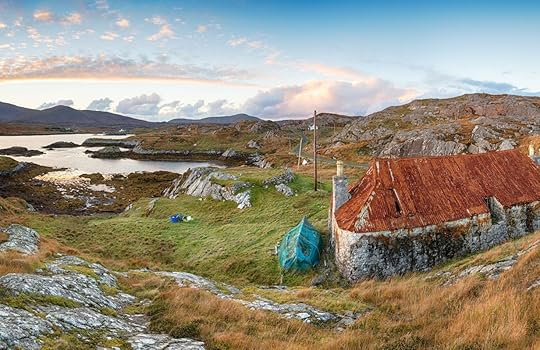
Photo: Helen Hotson/Shutterstock
Unlike Skye, there’s no way to access Lewis and Harris island except by ferry, so getting there is pretty straightforward. Just take the ferry from Uig in northern Skye to Tarbert on Lewis and Harris, which takes about two hours. While it might sound like two separate islands, it’s actually two parts of the same island.
Once in Tarbert, your eye will immediately be drawn to the ruins of Tarbert Castle overlooking the harbor. Rebuilt in the 14th century by Robert the Bruce, the castle is a great hiking destination, with signposted footpaths leading up to the ruins alongside Loch Fyne Gallery. If you want to spend more time around town before exploring the rest of the island, charter a morning ferry to Handa Island, which is home to over 250 pairs of puffins, as well as otters, dolphins, minke whales, pilot whales, porpoises, orcas, and sharks.
Once you’ve finished in Tarbert, it’s time to drive an hour south to the Calanais Standing Stones. If you didn’t get enough stone circles on the Isle of Arran, Lewis and Harris will certainly quench your thirst. Placed on a ridge above Loch Roag, these stones have been standing for over 9,000 years, but no one is entirely sure why they were constructed or the significance of the circular formation.
For more Scottish island history, head over to Gearrannan Blackhouse Village just under 20 minutes north of the stones. These nine coastal cottages have been restored to resemble the original croft houses Scottish islanders once lived in, and you can even rent the dwellings out for yourself. Spending a night in these traditional cottages, located within easy walking distance of Dalmore and Dalbeg beaches, is the perfect way to cap off your Scottish island adventure. 

More like this: How to plan an epic road trip through the Scottish Highlands
The post How to plan an island-hopping adventure through Scotland appeared first on Matador Network.

Things to do in Luxembourg
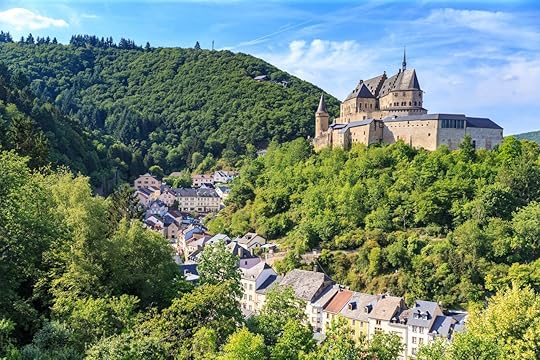
Traveling to Europe is the ultimate vacation for many Americans, who have long fantasized about sipping wine in Bordeaux or chowing down on bratwurst in Munich. The small country of Luxembourg might not be top-of-mind for travelers to Europe, but it should be. Often overlooked in favor of larger, more glamorized countries, Luxembourg is sandwiched between Belgium, Germany, and France, and has a fascinating blend of all three cultures. But despite having been heavily influenced by their neighbors, Luxembourgers still retain a distinct identity, even speaking Luxembourgish — a mixture of French and German. Luxembourg’s location makes it easily accessible to holidaymakers already vacationing in the surrounding nations, and since Luxembourg is even smaller than Rhode Island, it’s possible to see much of the country in just a few days. Here’s why Luxembourg is the perfect addition to your Eurotrip.
Start in the Ardennes
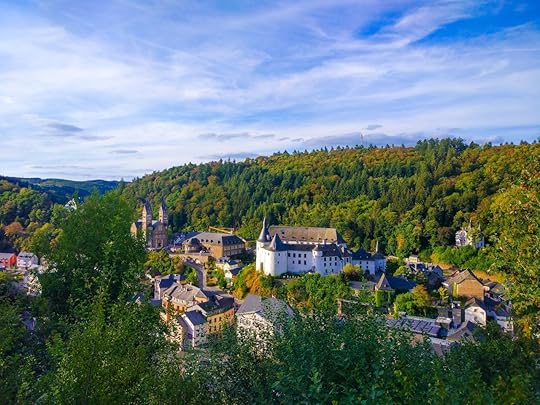
Photo: Jesus Barroso/Shutterstock
At pretty much the opposite end of the country from the capital of Luxembourg City — but less than an hour’s drive away — the small town of Clervaux is the perfect place to begin your Luxembourg trip. The town of just 1,300 sits in a narrow valley in the Ardennes Forest, and is dominated by the towering Clervaux Castle. Originally built in the 12th century, it was destroyed in the Battle of the Bulge during World War II, and has since been rebuilt. Many European towns are dominated by crowds, their medieval plazas filled with picture-snapping tourists, but Clervaux doesn’t have that problem.

Photo: Joan Wozniak/Shutterstock
Its chief attraction is the “Family of Man” photography exhibition, which you should visit even if you’re not an art connoisseur. Originally curated by Edward Steichen for New York’s Museum of Modern Art in 1955, the exhibit’s permanent home is now in Clervaux after having toured all over the world. Steichen’s famous collection of documentary art photography is part of UNESCO’s Memory of the World Register, and consists of 503 pictures by 273 photographers from 68 countries. The exhibition is rooted in powerful themes of love, birth, faith, work, family, education, children, war, and peace.

Photo: page frederique/Shutterstock
After you’ve toured the exhibit, be sure to try some classic Luxembourgish fare down the road at Restaurant Les Ecuries du Parc. Yes, Luxembourgers have their own distinct cuisine, and one proud citizen accurately described it as “French quality in German portion sizes.” Keep an eye out for bouchée à la reine (a stuffed pastry filled with chicken, mushrooms, and a thick sauce), Judd mat Gaardebounen (smoked pork with beans), bouneschlupp (green bean soup), and cheval (horse, which tastes more like steak than you’d think).
Along the German border

Photo: Pigprox/Shutterstock
From Clervaux, head south alongside the German border to Echternach, which will be your gateway to some of the best hiking trails in Europe. On the way, however, set aside time to stop in Vianden, about half an hour from Clervaux. Vianden is known for its hilltop castle, which is one of the most impressive in the entire country. The best way to reach the castle is via chairlift, which takes you from the city streets, through the trees, and up 1,440 feet to the castle. The lift is the perfect way to see the city from above. And once you’ve thoroughly explored the castle, you can hike back down into town through the woods. It’s a steep trek, but much more manageable than the upward climb.
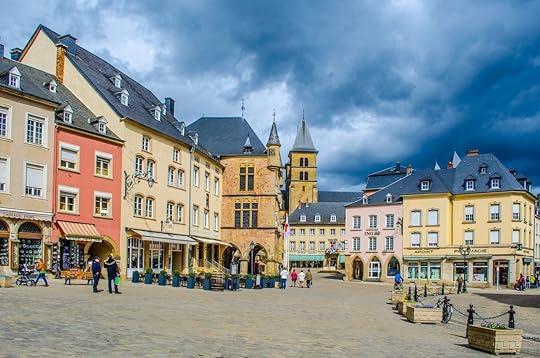
Photo: trabantos/Shutterstock
A half-hour southeast from Vianden, the town of Echternach sits on the banks of the Sûre River, right on the border of Germany. Saying Germany is just a stone’s throw away would be an overstatement, as a three-minute walk across the bridge will bring you to the German town of Echternacherbrück. But crossing the border won’t be necessary. There’s plenty to do in Echternach, like exploring the seventh-century abbey, wandering the old town square, or sitting at the patios of the many bars, restaurants, and cafes. And if you’re eager to explore Luxembourg’s wilderness, Echternach is the ideal gateway to the Mullerthal Trail.
The Mullerthal Trail
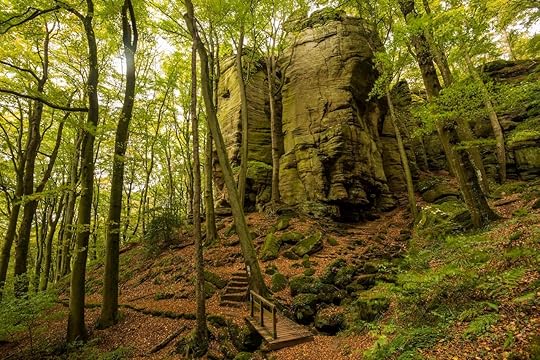
Photo: Bert Beckers/Shutterstock
The 70-mile Mullerthal Trail is home to some of the best hiking and cycling in Europe and consists of three big loops. The first loop begins in Echternach, and will bring you west toward Rosport along the Sûre River. You will be walking through a green forest and passing alongside some epic-looking rock formations. The trail loops around through Moersdorf and the forest of Herborn before ending back in Echternach.
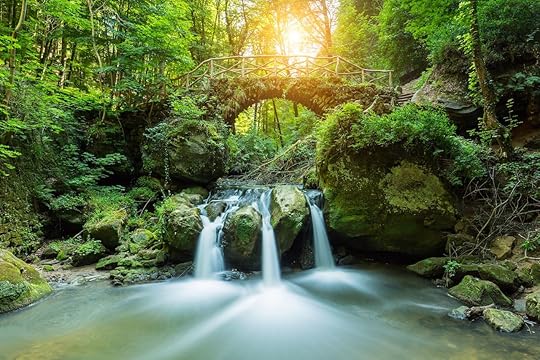
Photo: r.classen/Shutterstock
Loop Two, which also begins in Echternach, follows the woods east instead of west. It’s notable for Wolfsschlucht — a dramatic canyon lined with massive moss-covered rock formations. Perekop Rock, past the canyon, is one of the most imposing rock formations you will see on the entire trail, and just beyond that is Huel Lee cave, where you can choose to sleep if you don’t mind roughing it. You’ll pass through the village of Berdorf, Mullerthal, and Consdorf before returning to Echternach, but not before seeing the Schiessentümpel cascade or Kuelscheier crevice. If you’ve hiked up an appetite, keep an eye out for Brasserie Heringer Millen, a local mill in Mullerthal that has been converted into a restaurant.

Photo: Denis Radermecker/Shutterstock
The third loop can begin in a few different places, but the town of Mullerthal is probably the easiest. It will take you from Mullerthal along the Black Ernz river, through the valley of Halerbaach, and to Beaufort Castle. The castle is famous for producing black currant liqueur, and you’re highly encouraged to make a pitstop there to sample it. If you haven’t had enough castles on this trip yet, you can also spend some time in the town of Larochette, which sits in the shadow of a 12th-century castle. Loop Three will also bring you past the Scheissendëmpel cascade, as well as a cavernous pool of water called Kallektuffquell. From the cascade, it’s just one mile back to the town of Mullerthal.
Luxembourg wine country
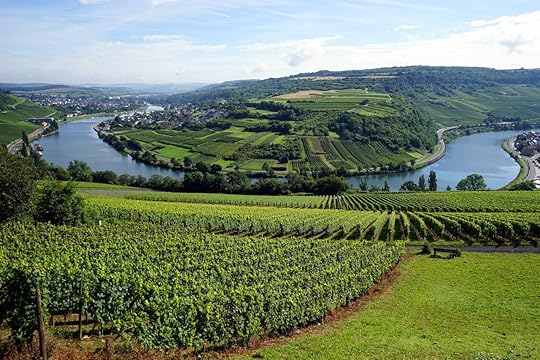
Photo: Valery Shanin/Shutterstock
Luxembourg’s Moselle Valley in the south can hold its own with the great wine regions of Europe, producing Riesling, Pinot Gris, Chardonnay, Pinot Noir, and others. To really drink like a Luxembourger, though, you need to try Crémant — the unofficial wine of Luxembourg. This sparkling wine can be found all over the country, and is Luxembourgers’ drink of choice for many occasions, from happy hour to aperitifs.

Photo: trabantos/Shutterstock
For a truly authentic Luxembourg wine experience, visit the Kox winery in Remich. This family owned operation has been producing Luxembourgish wines since the 1970s, and continues to offer tours and tastings. After you’ve stocked up on wine, carve out some time to stroll along the tree-covered promenades of Remich, where you can enjoy your new libations in a serene and picturesque atmosphere.
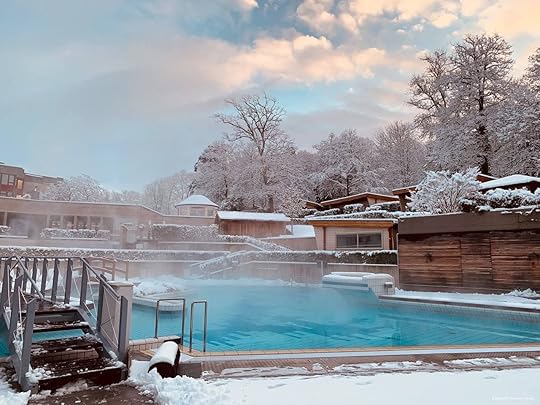
Photo: MONDORF Domaine Thermal/Facebook
And if you need to rest after a stressful day of wine tasting, the Mondorf Parc Hotel is just 10 minutes from Remich. This hotel is the region’s premier spa, and while it might not look anything like England’s Thermae Bath Spa or Budapest’s fancy thermal spas, it does offer a full suite of massage services. There’s also an outdoor spa complex with pools of varying temperatures, and many saunas and steam rooms. If you’re looking for the perfect way to cap off your Luxembourg trip, a spa night certainly isn’t the worst option. 

More like this: Luxembourg’s Mullerthal Trail is the most underrated hike in Europe
The post Luxembourg is the ultimate add-on to your Europe trip appeared first on Matador Network.

English Channel crossing on fly boar
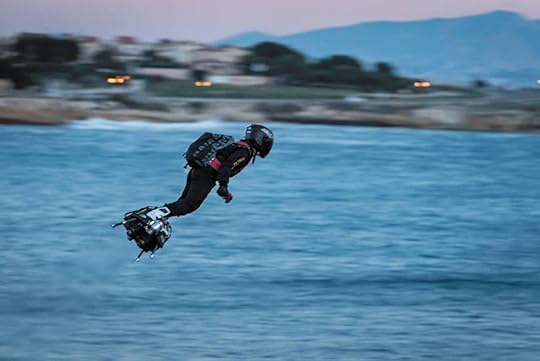
It might not sound impressive to hear that someone just flew across the English Channel — until you learn that they did it on a jet-powered hoverboard.
French inventor Franky Zapata crossed the English Channel on a flyboard, his own invention, on Sunday. He zoomed from Sangatte near Calais, France, to Saint Margaret’s Bay near Dover, England, in just 22 minutes, 50 to 65 feet above the water. The invention was powered by a kerosene-filled backpack and reached speeds of up to 110 mph.
Sunday’s feat was Zapata’s second attempt to cross the body of water. His first attempt took place on July 25 of this year, but failed after complications while refueling mid-flight.
If Zapata’s flyboard looks familiar, it’s because it stole the show during Paris’ annual Bastille Day parade last month. The board isn’t as out of place in a military parade as you might think — the French military has given Zapata’s company a $1.4 million grant, with the hopes of adapting the technology for use as a logistical or assault platform. 

More like this: The 7 coolest airplane liveries in the world and the stories behind them
The post French inventor crossed the English Channel on a jet-powered hoverboard in just 20 minutes appeared first on Matador Network.

44 injured by wave at water park

Amusement parks, despite their terrifying rides, are mostly safe. But accidents do happen, like the unfortunate event that took place at Shuiyun Water Park in the city of Longjing in northeast China.
Forty-four people were injured when a wave machine at the park malfunctioned, sending a massive wave crashing over the many swimmers at the “tsunami pool.” Footage from a guest shows the terrifying accident happened while the pool was packed with visitors of all ages.
“According to the initial stages of the investigation,” said the South China Morning Post, “the incident was caused by a power cut that damaged electronic equipment in the tsunami pool control room, which led to the waves in the tsunami pool becoming too big and injuring people.”
Although online rumors suggest that the wave was the result of an intoxicated park worker, it’s more likely that it was caused by a simple mechanical error. The park closed for a day for repairs, but is now open again for business. 

More like this: The 7 coolest lazy rivers in the world to beat the heatwave this summer
The post 44 injured by massive wave at Chinese water park appeared first on Matador Network.

How to order at Korean barbecue

It’s easy to see why Korean barbecue holds such a special place in the hearts of many Americans. It’s a meal where friends can settle at the table for a night of riotous fun, pass around shot glasses of soju, and swill beer between rounds of greasy, smokey, grilled beef ribs and pork belly. It’s a communal meal best enjoyed with people you love, a place to go to celebrate and let loose. Korean barbecue encompasses some of the best South Korean dishes.
It’s also best experienced in a restaurant setting. From the tasty pickled dishes and the smoking charcoal grill to the tall bottles of Korean beer, eating at a Korean barbecue restaurant should be at the top of any culinary adventurer’s bucket list.
There’s just one thing you have to ask yourself before diving in headfirst: how do you order, cook, and eat Korean barbecue? It’s a culinary style steeped in ritual, and there are some unspoken rules that will help you expertly navigate the menu and the dinner table.
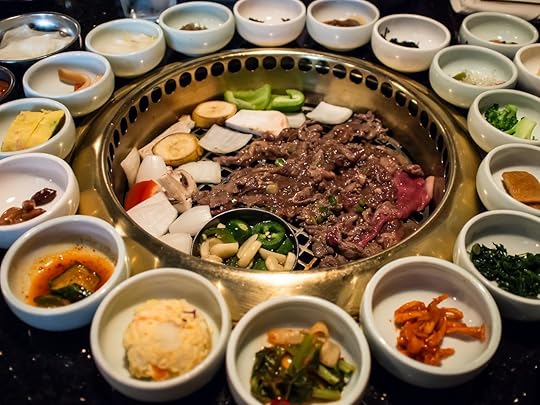
Photo: Joop Ang/Shutterstock
Grilled meats first emerged in Korean cuisine in the Goguryeo era (37 BC to 668 AC), according to Korea Journal. These dishes were known as maekjeok, and were served on a skewer (like a kabob). Eventually maekjeok evolved into seoryamyeok, marinated beef soaked in cold water. By the 19th century, strips of marinated meat favored mainly by Korea’s elite became known as neobiani. Marinated and grilled beef became more widespread in the 1920s, when beef production went commercial. The dish then dropped in popularity during the 35-year Japanese occupation of Korea, during which severe beef shortages made meat prohibitively expensive. Bulgogi eventually emerged in the 1960s, and by the 1990s it had become one of the most popular dishes in the country.
What is bulgogi, and what should you order at a Korean barbecue restaurant?

Photo: Suzi Pratt/Shutterstock
Korean barbecue meats are famously tender and juicy. The most well-known is bulgogi, which are thin strips of beef sirloin that are marinated and then grilled. Its irresistible texture and flavor is the result of a traditional marinade typically made with sesame oil, scallions, garlic, black pepper, and ginger. Slices of fruit, most commonly Asian pear, are crucial to this mixture, as the enzymes in the fruit help tenderize the meat.
Along with bulgogi, there are a few more meat options that you’re likely to find at almost every Korean barbecue restaurant: galbi, marinated and boneless beef short ribs; dak galbi, marinated chicken; samyeopsal, pork belly; chadolbaegi, thinly sliced beef brisket; and deung-sim, beef sirloin.
What is banchan?

Photo: Anchalee Wiangkao/Shutterstock
Along with the main meats, a Korean barbecue meal isn’t complete without a series of acidic side dishes called banchan. Though Korean barbecue spotlights meat, vegetables are an essential part of the meal. The most common varieties of banchan include pickled radish, mung bean sprouts, pickles, eggplant, and kimchi (pickled cabbage).
Of course, side dishes of rice to enjoy with your meat are also a must. Another popular accompaniment to the greasy barbecued meat is cold noodles, which can either be wrapped around the chunks of meat or enjoyed at the end of the meal to counter the spice and smoke from the grill.
Small ramekins filled with aromatic dips and sauces will also appear at your table. The most common among these are sesame oil, ssamjang (a combination of soybean and chili paste that pairs well with galbi and bulgogi), and gochujang, a spicy, sweet, and sour sauce also known as hot pepper paste.
How to order Korean barbecue
Menus at Korean barbecue restaurants tend to be expansive, listing the popular dishes like bulgogi alongside more adventurous options like beef tongue, squid, small intestine, and pork jowl. Diners who are eager to experiment might be tempted to sample one of everything on the menu — just don’t get overzealous. The restaurant’s menu won’t always specify the amount of meat in each serving, so it’s probably smart to start small. Order one serving of meat per person. If you need more, you can always order it. The short ribs and pork belly should be at the top of your list.
How to cook and eat Korean barbecue

Photo: Zephyr_p/Shutterstock
You typically cook the meat at a small grill attached to the table. Traditionally, Korean barbecue is cooked over charcoal, but some restaurants use a simple burner. At most Korean barbecue restaurants, you’ll be given tongs to flip your meat and remove it from the grill once it’s been cooked to your satisfaction. However, if you’re not comfortable flipping your own meat, your server will happily step in. Your server will also use a pair of scissors to cut the strips of meat into smaller, shareable pieces. The grill itself will likely be changed when you switch from beef to pork, or at least cleaned throughout your meal.
The galbi are cooked in long strips on the grill, then cut into pieces with scissors. Galbi is best enjoyed in a lettuce wrap (ssam), topped with ssamjang. Bulgogi, probably the best known Korean barbecue dish, takes just two quick minutes to cook on the grill, and can be seasoned with scallions or sesame seeds. Like galbi, bulgogi can also be served in a lettuce wrap. Eating ssam in one bite is considered good luck.
What to drink with Korean barbecue
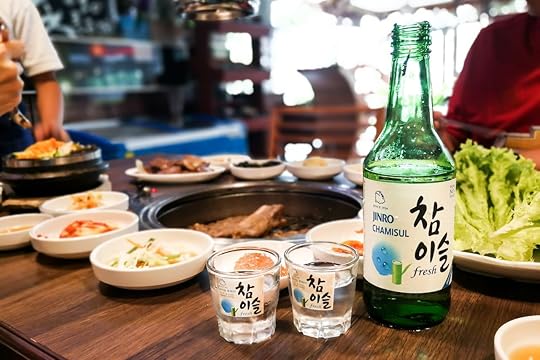
Photo: ThamKC/Shutterstock
Since dinner at a Korean barbecue restaurant is usually a group affair, the evening will likely have a celebratory, raucous atmosphere. Expect the drinks to flow liberally. The biting, clean tang of soju, a (usually) rice-based clear liquor with a low-alcohol content, is probably the best accompaniment to the hearty, filling, and greasy grilled meat on your plate. You’ll also find sake and beer on the menu. One traditional custom you might adhere to, especially if you’re dining out with a large group of friends, is to refrain from filling up your own glass. Instead, wait for your friends to fill it up for you, and show them the same courtesy in return. Just keep in mind that it’s easy for the drinks to add up this way. 

More like this: 12 essential Korean foods, from savory street snacks to live octopus
The post The ultimate beginner’s guide to Korean barbecue appeared first on Matador Network.

August 2, 2019
Where to find dinosaur bones
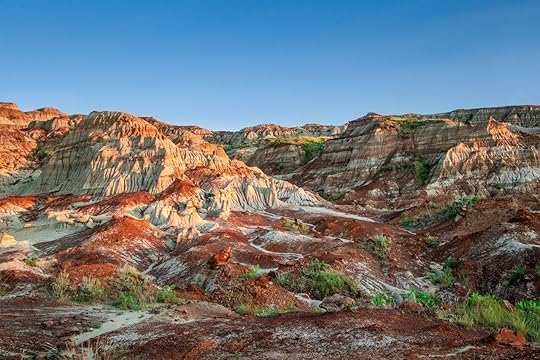
While the kings of the Mesozoic era are long gone, the remains of dinosaurs can still be found all over the globe. If you want to get up close and personal with the real deal, there are plenty of options. Whether you’re planning a trip to observe unearthed bones in museums or you’re ready to dig for fossils yourself, consider these dinosaur hotspots.
1. South Africa

Photo: Sara Winter/Shutterstock
There are few better spots in the world to see evidence of dinosaurs than the Austral tip of the African continent. According to Professor Jonah Choiniere, reader at the Evolutionary Studies Institute and an honorary senior lecturer at the School of Geosciences at the University of the Witwatersrand in Johannesburg, “66 percent of the surface of South Africa has fossils on it,” so your odds of finding the remains or impressions of long-gone fauna and flora are pretty high.
Hire a guide and take a fossil tour of Golden Gate Highlands National Park, three hours south of Johannesburg, where the oldest dinosaur nesting site (190 million years old), comprised of at least 10 nests that have 34 eggs and small footprints, was discovered in 2012. The Free State Province is also the site of the recent discovery of a new species of dinosaur, the 12-ton, plant-eating Ledumahadi mafube.
Note that if you find fossils while in South Africa, it is illegal and punishable by a fine and/or imprisonment to “destroy, damage, alter, deface, disturb, excavate, remove from its original position, collect or own, trade-in or sell, export or attempt to export” them without a permit from the South African Heritage Resources Agency.
2. Alberta, Canada

Photo: Nalidsa/Shutterstock
Drumheller in Alberta is not nicknamed the “Dinosaur Capital of the World” for nothing. First, it has the world’s largest dinosaur, a 65-ton, 86-foot-tall female Tyrannosaurus rex that visitors can climb; the sculpture is over four times bigger than a real T. rex, but it still makes for the ultimate photo-op for dino-lovers. Second, it’s the home of the Royal Tyrrell Museum, the only museum dedicated to paleontology in Canada, which also has one of the largest displays of full dinosaur skeletons out there. But if you want to awaken your inner archaeologist in the otherworldly Badlands, drive 100 miles southeast to Dinosaur Provincial Park, a UNESCO World Heritage site named appropriately for its bountiful paleontological resources. Access to the park is only possible by booking a guided tour, such as the Centrosaurus Quarry Hike to see a former dig site, a fossil prospecting tour, or a two-day fossil excavation with an experienced paleontological technician. Note that there are laws against simply nabbing them, so don’t pocket what you find.
3. Jurassic Coast, United Kingdom

Photo: Fulcanelli/Shutterstock
While this UNESCO World Heritage site on the English Channel coast of England is well-known for its stunning landscapes such as the iconic Durdle Door, the Jurassic Coast is also a site incredibly rich in fossils from all three periods of the Mesozoic era — Triassic, Jurassic, and Cretaceous. Dating back as far as 185 million years ago, the fossils at the Jurassic Coast attract both professional archaeologists and amateur enthusiasts. If you want to try your hand at fossil hunting, certain stretches of the coast — such as Charmouth — are open to the public for collection. To see examples of fossils found on the Jurassic Coast, visit the Natural History Museum in London, where some of the extraordinary discoveries of Mary Anning, 18th-century paleontologist, and fossil collectors, are displayed.
4. Mongolia
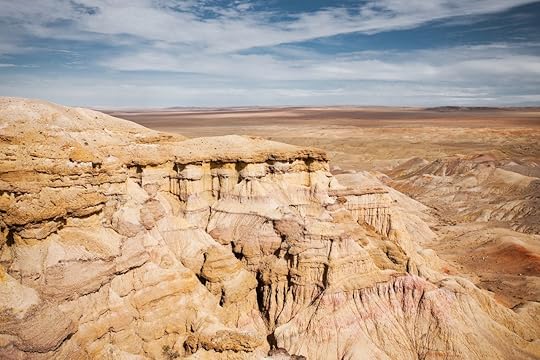
Photo: Pius Lee/Shutterstock
In the early 1920s, an expedition headed by scientist Roy Chapman Andrews (the alleged inspiration for Indiana Jones) into the Flaming Cliffs of the Gobi Desert was launched. Within the red landscape of Mongolia, Andrews and his team made many impressive discoveries, including the first nest of dinosaur eggs known to science, currently displayed at the American Museum of Natural History in New York City.
The Gobi Desert is thought to be the site of a mass extinction of dinosaurs, so the place is the motherlode of bones, eggs, teeth, and prints. In 2016, some of the largest dino footprints (42 inches) were found in the Mongolian desert, and over the years, 47 dinosaurs were found in Mongolia. Many of the area’s findings are now on display at the Central Museum of Mongolian Dinosaurs, located in the capital city of Ulaanbaatar. Dinosaur tours of the Flaming Cliffs paleontology site, such as National Geographic’s “Discover Mongolia” expeditions, are available.
5. Hawaii, United States
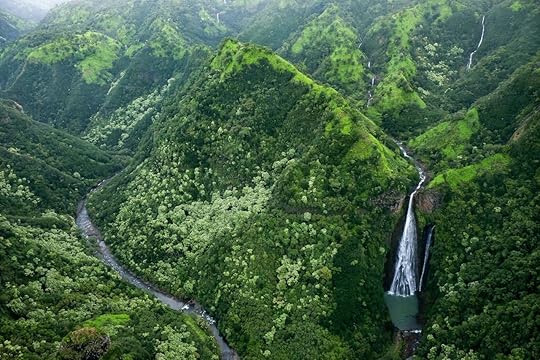
Photo: Bridget Moyer/Shutterstock
For those who got their fascination for dinos from pop culture, head over to Hawaii where much of the Jurassic Park franchise was filmed. While you won’t find any giant cloned dinosaurs roaming around, you will find many photo-ops at the filming locations, particularly on the islands of Kauai and Oahu. On Kauai, visit Manawaiopuna Falls (aka Jurassic Falls), where the helicopter lands in the first film, and the famous Na Pali Coast, which is featured in both Jurassic Park and Jurassic World in the scenes where guests arrive on fictional Isla Nublar. The only way to see the falls is from the air as it’s located on private land, so you’ll need to book a helicopter tour. To get a view of the gorgeous Na Pali Coast without the pricey air tour, hike the Kalalau Trail. On Oahu, spend the day soaking up the sun at the secluded Halona Blowhole (where Owen, Claire, and Franklin wash ashore in Jurassic World: Fallen Kingdom).
6. Montana, United States
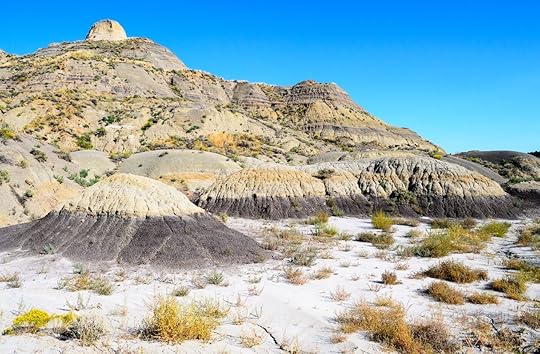
Photo: Zack Frank/Shutterstock
One of the most well-known dinosaur fossil deposits in the world is Montana’s Hell Creek Formation, where one can easily find the remains of dinosaurs if they are willing to get their hands dirty. Proof of the extraordinary discoveries that can be made in this corner of the United States is Clayton Phipps’ incredible find. In 2006, Phipps, a Montana cattle rancher passionate about dinos, uncovered the extremely well-preserved fossil of a Triceratops horridus and a T. rex who seemingly died fighting each other. Note that collecting fossils in Hell Creek is illegal unless you have a permit from the appropriate federal land management agency or permission from the owner of that particular plot of land. To avoid any accidental fees, it is best to join public digs. Alternatively, Montana is also home to the Bighorn Basin Paleontological Institute, a nonprofit dedicated to paleontology and earth science research. The institute offers dino-hunting and fossil-collecting expeditions for children, teens, college students who wish to earn credits, and passionate adults.
7. Yucatán Peninsula, Mexico
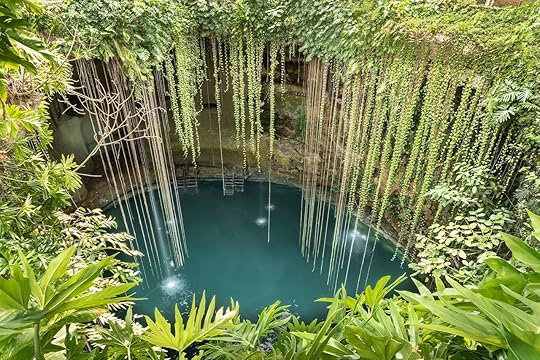
Photo: Leon Rafael/Shutterstock
It has been long speculated by scientists that it was a deadly asteroid impact that wiped out the dinosaurs. The leading theory is that the apocalyptic asteroid landed in present-day Mexico, near the coast on the Yucatán Peninsula. The resulting crater is the Chicxulub crater, named after the nearby port town, Chicxulub Puerto. The Yucatán Peninsula’s famous cenotes — sinkholes filled with incredibly clear water — are the result of the impact. Take a dip in one of these cenotes, which were instrumental in the discovery of the crater. This 66-million-year-old crater is an excellent place to learn about geology and the factors that triggered global extinction. While you won’t find any dinosaur bones laying around here, you can still head over to the Museo de Ciencias del Cráter de Chicxulub to see fossil displays and other geological exhibits. 

More like this: Archaeological digs around the world you can actually partake in this year
The post The 7 best destinations for dinosaur nerds appeared first on Matador Network.

Baseball Hall of Fame, Cooperstown

There are a painful number of clichés about “home.” Home is where the heart is. Home is where your stuff is. You can never go home again. I’ve never found any of them to be particularly true.
Home, I think, is where your memories are. The highly filtered memories of an easier, simpler time you wish you could go back to when adult life seems just a little too…adult. Home isn’t necessarily a place, but an era. And is as much the people who surrounded you and the things you did than anything tangible.
When you’re a kid, sports are the constant of home. They were your biggest concern in a time where you didn’t have many, and the guys you watched on TV were the best friends you never got to meet. Baseball, more than any other sport, is the official sport of “home.” It’s what your dad had on the TV every night from April to October, and what was on the radio when he picked you up from practice or a friend’s house. It has a pace and a conversation that makes for the perfect perpetual backdrop. Baseball was what was going on in the background while life happened.
For me, home was sunny summer days in Northeast Seattle, listening to the hapless Mariners on the radio while cruising around in my friend Dan’s shitty Chevy Corsica. It was watching games in our friend Joe’s basement and on the TV in the neighborhood pizza joint where I worked. And going to the nearly empty Kingdome with our parents to see Ken Griffey Jr. and Edgar Martinez do their best to help a terrible team.
Then in 1995, just when we were getting drivers’ licenses and discovering girls, another crazy thing happened: The Mariners actually started winning. And all of a sudden all that mattered in life was baseball.
Dan and I weren’t best friends, really, but we were baseball friends. And though neither of us was going to be the best man at the other guy’s wedding, we also realized we’d remember that Mariners run a lot more than we’d remember anything we learned in school.
So we took a page from Zack Morris’ book and skipped on Rosh Hashanah to see a crucial day game against Oakland. We told teachers we were attending services at Temple Beth Kingdome.
We skipped the whole day for a one-game playoff against the California Angels. The next day our fifth-period chemistry teacher asked if we had excuse notes. We handed him our ticket stubs and he said, “That’ll work.”
The year’s ultimate moment was a two-run double hit by Edgar Martinez to beat the villain of all villains — the New York Yankees — in a playoff series. It’s still the most iconic moment in Seattle sports history, Super Bowls and all.
So when Martinez — the guy who hit that ball, and the greatest designated hitter in history — finally got the call to the Baseball Hall of Fame in Cooperstown, we knew we had to skip life for a few days to see it.
The mother ship of baseball fans sits in upstate New York
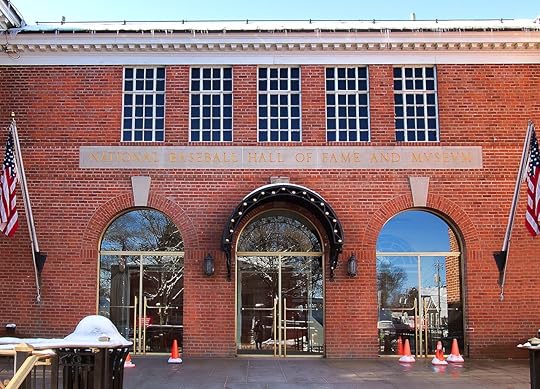
Photo: debra millet/Shutterstock
Cooperstown is an odd little place. It’s a village of just over 1,500 people that looks like any charming small town in America. Except instead of bars, restaurants, and law offices on its main street, it has the Baseball Hall of Fame and about 700 memorabilia shops.
It’s nestled in the Adirondacks, surrounded by stunning green hills along a deep blue lake. On a bright summer day, it didn’t look too different from Seattle.
During induction weekend, the shops along Main Street are your childhood baseball card collection come to life. Ozzie Smith is signing autographs in one store, Cal Ripken in the next. Wade Boggs in another. Everyone you knew only from a wax-covered piece of cardboard is there in the flesh, shaking hands and breathing the same air.
For baseball people, it instantly feels like home. Because baseball people, we’re not so common anymore. And trying to talk baseball to a lot of people now is tough.
“It’s so boring,” they’ll say, the nuance of a 2-2 curveball and a drag bunt lost on them to bone-jarring hits and three-pointers. “It’s so slow, I fall asleep. I like to just go to games and drink.”
And that kills a baseball person a little bit every time we hear it. But in Cooperstown, that spirit is revived. For baseball people, Cooperstown feels like home in the same way burners talk about being “home” at Burning Man. It’s where your people are, and where every corner of every street speaks to a part of you many people don’t understand.
The day before the induction, the Hall of Fame hosted a roundtable of Mariners greats at Doubleday Field, where Ken Griffey Jr., Jay Buhner, and other guys we grew up idolizing were dressed down and talking baseball.
“That’s Griffey!” Dan said with the same excitement he might have if we’d run into him at a traffic light in 1995. In a previous life, Dan was a sportscaster and had become immune to the novelty of meeting famous athletes. But something about Cooperstown strips that all away.
“Really?” I said as we stood about six feet from Seattle’s ultimate sports hero. “Man, he got fat.”
It didn’t matter. Heroes are heroes no matter how much weight they gain.
The stands were packed with a thousand or so Mariners fans decked out in Edgar Martinez jersey shirts. Two thousand miles from Seattle, we were all sharing the same memories together with the guys who made them possible.
Reliving a common past with total strangers
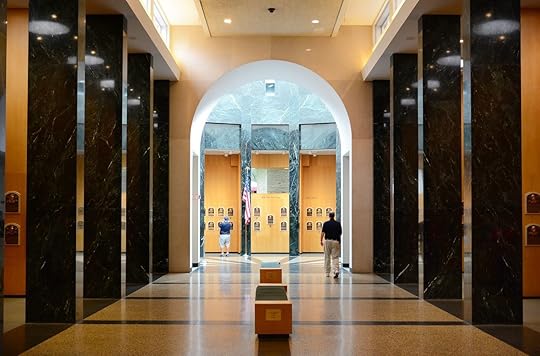
Photo: LunaseeStudios/Shutterstock
The induction ceremony felt like the last scene in a movie about the ‘95 Mariners. Randy Johnson and Ken Griffey Jr. sat onstage while Edgar Martinez was inducted into the Hall of Fame. It was the flash-forward from those simpler days in the Kingdome, with grown-up fans watching their heroes and remembering what it was like to be kids.
We talked about baseball and told old Mariners stories with people we’d never met, forgetting about anything else except maybe where to get our next beer. Dan checked in with his wife a few times a day, but other than that we were as free as we’d been in the ‘90s and it felt good to immerse ourselves in a glorious past.
As we did after so many classic Mariners games, Dan and I drove back from the ceremony blasting Snoop Dogg at ill-advised volumes and driving faster than we probably should’ve. As the sun set over the Adirondacks, for that brief moment we were carefree teenagers again, celebrating a sports victory from the front seat of a shitty car to a ‘90s rap soundtrack.
Neither of us can ever go home again. His parents sold their house and moved close to him in Charlotte. My parents are both long gone and I live as far from Seattle as you can get. The Kingdome was imploded 20 years ago, and Seattle is barely recognizable from what it was in the heyday of Edgar Martinez.
But for one weekend, we came close. And even though it was in a little town in upstate New York, it felt like those Seattle summers when life revolved around baseball. Responsibility slipped away and the simple life roared back for a few magical days, proving that in the right state of mind, you really can go home again. 

More like this: Manhattan is getting a beach and it will look like a little corner of paradise
The post They say you can’t go home again, but going to Cooperstown is close appeared first on Matador Network.

Sonoma or Napa
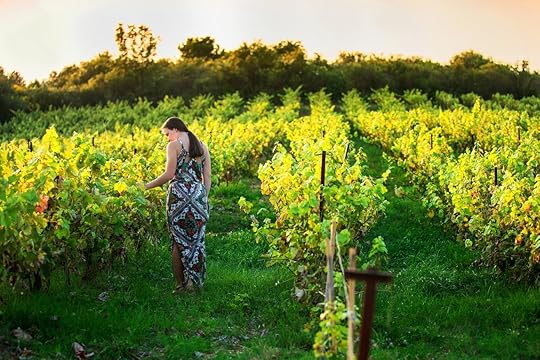
If Napa Valley is the poster child for California wine country, then Sonoma County is its little sibling. It’s casual, affable, and not at all competitive, like a kid brother who eked out a few inches on his big sibling after a growth spurt.
Sonoma is sprawling, home to roughly as many wineries as Napa yet spread across twice as much land. The land itself is made up of 31 different soil types, according to the Sonoma County Winegrape Commission, creating distinct characteristics in the county’s 18 American Viticultural Areas (AVAs).
On the whole, wineries in these appellations just past Napa are more accessible and affordable. Some, like the Russian River Valley, stand out above the rest. While many who are new to California wine, or wine in general, are seduced by Napa’s name recognition, first time tasters will find a better introduction in the heart of Sonoma. All they have to do is keep on driving.
A taste of Burgundy outside of France
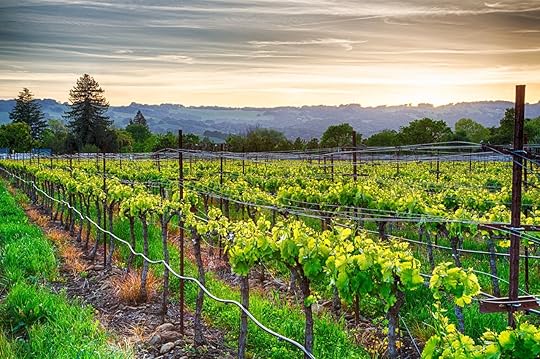
Photo: Gary C. Tognoni/Shutterstock
Ever since Napa wineries Chateau Montelena and Stag’s Leap rocked the 1976 Judgement of Paris, beating out French wines in both white and red blind tastings, the appellation’s cabernet sauvignons and chardonnays have been coveted as much as bottles from Bordeaux.
Then, sometime after the movie Sideways hit the big screen, another grape became a cornerstone of Northern California’s vinitourism: pinot noir. California wine insiders know to skip Napa when craving pinot noir, and they also know they’ll find equally exquisite chardonnays when they reach Sonoma. Out of Sonoma’s many AVAs, none produce pinot noir quite as elegantly as Russian River Valley wineries, most of which lie in and around the city of Healdsburg.
Healdsburg is smaller and more relaxed than faux-casual Napa, and is frankly the most charming tasting base this side of Burgundy. The small city offers a provincial pace without pomp, and has easy access to the appellation’s best wineries. It’s grown since Sonoma carved a space of its own in the wine world, with accommodation options ranging from California chic hotels like the Harmon Guest House to the easier-on-the-wallet Best Western Dry Creek Inn. There’s also a quaint downtown plaza lined with dog-friendly cafes, a couple of restaurants worthy of a splurge, and a lone dive bar.
There isn’t much to do in Healdsburg outside of winery visits and meandering walks, but the fact that it isn’t dripping with golf courses and luxury spas is precisely what makes it so appealing and a small sample of what Napa must have been like before 1976.
The cool, coastal climate builds complex flavors

Photo: AevanStock/Shutterstock
Healdsburg sits just over an hour northwest of Napa, but the 50 or so miles between them has a considerable impact on the grapes grown in their respective counties. The Russian River Valley is foggier and more breezy due to its proximity to the ocean, which results in a slow ripening process. This environment builds complexity in both flavor and aroma.
“Everywhere we grow grapes is affected by the Pacific,” said Craig McAllister, the head winemaker at La Crema, a Russian River Valley staple that sources its grapes locally but also from Monterey, California, and Oregon’s Willamette Valley.
Grapes vary depending on the appellation, whether it be the Russian River Valley, Alexander Valley, Anderson Valleys, or any other. Closer to the ocean, grapes tend to be brighter and more tart, resulting in a wine with notes of “pomegranate, raspberries, and barely ripe strawberries,” explained Ryan Zepaltas, who worked at La Crema before becoming the general manager and head winemaker at neighboring Copain. Just inland, where it’s slightly warmer, wines tend to have a “bing cherry, cedar kind of vibe” and “tend to be a little bit rounder, riper, so they’re going to be more lush,” Zepaltas said.
Both pinot noir and chardonnay, which represent the majority of the Russian River Valley’s vines, thrive in the cool, coastal climate, but they’re certainly not alone. Sonoma County vineyards also have syrah, the odd pinot gris, Gewürztraminer, and other varieties on offer. All are effortlessly drinkable and food-friendly, promising a little something for everyone and a real treat for those just getting acquainted.
A cool, casual attitude leaves room for imagination
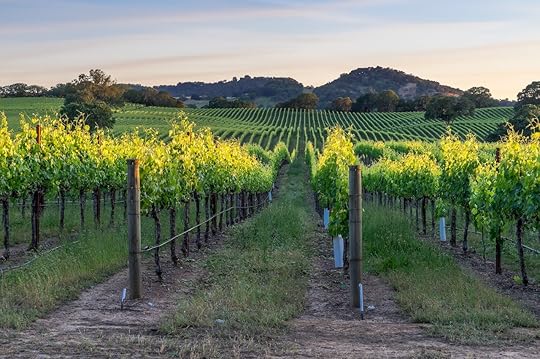
Photo: Alexandra Latypova/Shutterstock
Zepaltas exemplifies the winemaking ethos in the Russian River Valley. Born in Wisconsin and raised on beer culture, Copain’s head winemaker never quite lost his Midwestern roots (the brewery haven of Santa Rosa is roughly 20 minutes south of Healdsburg). The afternoon I visited, he spoke as much about his skateboarding past, still dressed the part in a plaid button-up and black baseball cap, as he did about the wine pairings we had with lunch, a table’s-length spread of grilled salmon, salads, and farm-fresh sides.
After lunch, we left the tasting room for a tour of the winery’s barrel rooms, passing a mobile bottling operation with Latin music blaring and a small crew, all smiles, dancing in time with the conveyor belt. There, standing before row after row of French oak barrels, Zepaltas explained his interest in making high-acid, low-alcohol wines rather than high-alcohol wines with a lot of flavors from new American oak barrels.
“In California in the early 2000s, everybody was trying to see who could flex the biggest muscles,” he said, “where we think you can make plenty of powerful wines at lower alcohol levels.” Copain’s pinot noirs range from 12 percent to 13 percent ABV, with a sweet spot around low 13 percent, according to Zepaltas. This is similar to Napa wines circa the 1970s.
Bunking tradition and taking risks are two of the benefits of making wine in the Russian River Valley. These wineries are free from the pressure of being Northern California’s most-recognized wine region. Winemakers here are more concerned with making wine they’d want to share with friends and family over a meal rather than something solely for the visitors coming through for tastings.
Affordability that doesn’t come at a price

Photo: haveseen/Shutterstock
For people who think wine labels read like hieroglyphics, who don’t know their preferences beyond red or white, or who haphazardly grab bottles at the supermarket, price is generally the deciding factor when choosing wine. The same is true for tastings. Perhaps the biggest incentive for newer wine drinkers to choose the Russian River Valley and its Sonoma County kin over Napa Valley is, simply, that it’s cheaper without skimping on quality.
Where most tastings in Napa will run you between $20 and $50, Sonoma tastings tend to hover between $15 and $25 dollars. Those willing to shell out twice as much can enjoy more curated experiences in the Russian River Valley. There’s La Crema’s North to South Flight VIP tasting, which samples wines made from grapes from Oregon all the way down to Monterey and includes a tour from educated guides. The experience costs $40 per person, with the option to add a picnic for two on the estate’s grassy knoll for an extra $25 per person.
At Copain, $40 per person will get you a five-wine Single Vineyard series tasting with small bite pairings at one of the site’s farm tables, whereas $60 per person bumps you up to six wines, private seating, and cheese and charcuterie pairings. 

More like this: How Sonoma became America’s most sustainable wine region
The post Drive past Napa for your first trip to Northern California wine country appeared first on Matador Network.

Need know about smog in Beijing

In planning a trip to Beijing, you will likely come across the word “smog” on a regular basis. Despite the government efforts to decrease air pollution and a successful drop on those levels over the last six years, smog is still an issue in Beijing and other cities throughout China. But don’t let that discourage you, being informed to make the best decisions will help you enjoy the city and hopefully avoid pollution altogether. Here’s the lowdown on how polluted the air really is and how this might affect your trip to China’s capital. Beijing’s amazing palaces, gardens, and temples are well worth the hassle.
Understanding the basics

Photo: testing/Shutterstock
The smog in Beijing is mainly caused by the use of coal power and and the extensive traffic that clogs city, though its geography also plays a part since the city is flat and surrounded by mountains that don’t let the wind take away the pollution. Air contamination is measured in terms of air quality index (AQI), which measures particulate matter, sulfur dioxide, carbon monoxide, and nitrogen dioxide, as well as ozone quality. A city’s AQI will fall between good (0-50), moderate (51-100), unhealthy for sensitive groups (101-150), unhealthy (151-200), very unhealthy (201-300), and hazardous (301-500). So anything higher than 100 affects health, especially in children, elders, and those with preexisting conditions such as heart or lung diseases. To give you an idea of what to expect, the average rating so far this year so far has been 105.
Immediate symptoms that you can experience if the AQI is very high are burning eyes, nose irritation, and an itchy throat. A natural way to fight the latter one is a dose of good ol’ honey mixed with lemon juice, most effective in case you get a cough. Your skin may also feel dry and in this case, you should shower when returning to your hotel and use a moisturizing cream. Normally, any visible effects will disappear within a week, and there is nothing to worry about long-term.
Best time to travel to Beijing to avoid smog
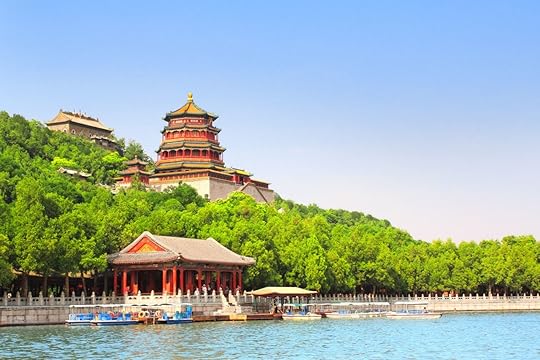
Photo: Lukiyanova Natalia frenta/Shutterstock
Although it is not an exact science, there are better and worse months in terms of air quality that you may want to take into account when deciding when to visit. Winter is the worst time to go to Beijing because the city’s water heating system is coal-powered and causes a lot of extra smog. The same thing happens during the height of summer, but because coal-based power plants have to generate more electricity needed for the air-conditioners.
Fall and spring are the best seasons to visit Beijing, with May and September being the best months within those seasons. October is great too because many factories are closed due to national holidays, which leads to drastically better air quality, but for the same reason, tourist hot spots are usually more crowded because many locals are off work for the holidays.
How to stay informed before and during your trip

Photo: HelloRF Zcool/Shutterstock
In 2008, the US Embassy in Beijing installed on its rooftop a monitor that measures the air quality. The monitor tweets this information hourly to let people know how the quality of the air is at that moment. Although it is only a reading of the Chaoyang District, the monitor provides a good sample of what you’d experience across the city as a whole. The tweet shows the current AQI as well as the level of health concern, ranging from good to hazardous.
Another useful app is Air Visual. Although it’s not Beijing specific as it reads worldwide information, it is helpful to see the current state of the air in at least 20 different sites in Beijing as well as in other cities. It also shows a seven-day forecast that will help you organize what to do during your stay. If you are more of a computer-type than a mobile person, you can also see this information online posted by the AQICN. There, you will see the information from the past 48 hours as well as a seven-day forecast.
What to do if the pollution index is high during your stay

Photo: aphotostory/Shutterstock
There are a few things you can do to mitigate the situation should you find yourself choked by smog while in Beijing. The first is kind of obvious, but staying indoors reduces the exposure to air polluted particles by 20 percent. Luckily, there are plenty of museums that you can go to such as the National Museum of China, the National Art Museum of China, and the China Science and Technology Museum, or you can pay a visit to the beluga whales at the Beijing Aquarium.
Those planning to visit the Great Wall should remember that there are many sections to visit, and some are further removed from the pollution than others. Visiting sections that aren’t the closest ones to Beijing on a polluted day not only gets you out of the city, but it also gets you further from the smog and the hordes of people. Huanghuacheng or Shanhai Pass are excellent choices although you should check beforehand to see what the air quality is like there — it can be nearly as bad even outside of the city.
If the forecast is showing that the next couple of days will have a high AQI, you may also want to consider doing a day trip or two-day trip to another city nearby. Fast trains make possible a getaway to other great places such as Datong or Chengde.
In the city, there are a few restaurants that offer air purification systems. Feast, located in the East Beijing Hotel in the Chaoyang District, serves both Asian and international food. Its brunch is especially recommended and it has vegetarian options. You could also go for a great cup of coffee, brunch, or dinner at Cafe Zarah, located in Dongcheng District, or Jing-A Brewing in Chaoyang District, which has the Airpocalypse IPA, a beer whose price goes down as much as the AQI goes up — a local’s favorite to venture for a cold one.
How to choose a mask that actually works

Photo: testing/Shutterstock
Before you venture anywhere in town, get yourself a mask that actually works, so not just a cheap surgical mask that covers only your mouth. The first thing you need to know is that all masks are measured with an anti-haze index that indicates its effectiveness in filtering particles in the air. As a rule of thumb, you need a model that has a number higher than N95, which means it filters 95 percent of particles in the air. These are some recommended masks for every type of budget:
Low budget: AQblue Plus+ filters up to 95 percent of the particles and it lasts two hours on a polluted day. You can buy it for around $13 via Taobao (a shopping website), selected hospitals, or WeChat (a Chinese messaging and social media app).
Medium budget: A Cambridge mask, which filters 99 percent of the particles and lasts 220 hours. You can get it on Amazon for $30 and it comes in different colors.
High budget: Respro masks are on the expensive side of the budget range, at around $50. You can pick either the Respro Techno or Respro Ultralight. These are the most recommended for people who exercise outdoors and it filters 99.7 percent of the particles. Its filters are removable and have a lifespan of around 69 hours, so you don’t need to throw it away, you only need to change it. These are sold separately at $25 per pair. You can buy both the masks and filters on Amazon.
If you are going to Beijing during the hazier months you might get away with either one of the first two if it’s only for a few days. For longer stays, invest a little more and get one of the Respro options. In all cases, the most important thing is that the mask needs to fit your face perfectly to avoid the air entering your body. It’s also recommended that you get them before going to China to make sure you get the one you want — around Beijing, they fly off the shelves once the API goes up. 

More like this: The 7 best places to catch a breath of fresh air near Beijing
The post Everything you need to know about smog in Beijing appeared first on Matador Network.

Baggage fees ranked

Budget airlines can be a real money saver (especially if you book with the best budget airlines). Some of the companies, like the new LEVEL with budget flights to Barcelona and Paris, are great to fly on. Others, not so much. But there’s one thing that’s pretty much unavoidable no matter which budget airline you take: baggage fees.
Some people have a lot of baggage, and that can add up. If you’re one of those people, try to avoid any unwanted surprises by checking the different airlines’ fees. These are the most popular domestic budget airlines in the US, ranked by baggage fees.
1. Southwest
Free baggage: One personal item, one carry-on bag, and two checked bags.
Baggage fees: Every checked bag after the second is $75 each.
2. JetBlue
Free baggage: One personal item and one carry-on bag.
Baggage fees: $30 for the first checked bag, $40 for the second. Blue Plus and Blue Flex fare options both include a free checked bag (one for Plus and two for Flex).
3. Alaska Airlines
Free baggage: One personal item and one carry-on bag.
Baggage fees: $30 for the first checked bag, $40 for the second, and $100 for each additional.
4. Allegiant Air
Free baggage: One personal item.
Baggage fees: Costs vary depending on your departure airport and are non-refundable. Carry-on costs range from $10 to $75. Up to four checked bags per person can be purchased, up to 40 pounds each. It generally costs $25 for a checked bag if you buy it when booking, $45 after booking but prior to check-in, and $50 if you check your bag at the airport.
5. Frontier Airlines
Free baggage: One personal item. If you purchase one of the two bundled ticket options (the perks or the works), one carry-on and one checked bag is included.
Baggage fees: Costs vary depending on when you purchase and are non-refundable. For a carry-on, it’s $30 to $35 when purchased at time of booking, $40 when purchased after booking but prior to check-in, and $45 at the ticket counter. For checked bags, it’s $30 for the first bag ($45 for the second and $80 for the third) when purchased while booking, $40 for the first bag ($45 for the second and $80 for the third) when purchased after booking but prior to check-in, and $45 for the first bag ($50 for the second and $85 for the third) when purchased at the ticket counter. Bags are $60 if you’re forced to check it at the security gate because of size.
6. Spirit Airlines
Free baggage: One personal item.
Baggage fees: Costs vary depending on when you purchase and are non-refundable. For a carry-on, it’s $37 when purchased at time of booking, $45 after booking but prior to check-in, $55 at the ticket counter, and $65 at the gate. For checked bags, it’s $32 for the first bag ($42 for the second and $87 for the third) when purchased at time of booking, $42 for the first bag ($52 for the second and $97 for the third) after booking but prior to check-in, and $52 for the first bag ($62 for the second and $102 for the third) at the ticket counter.
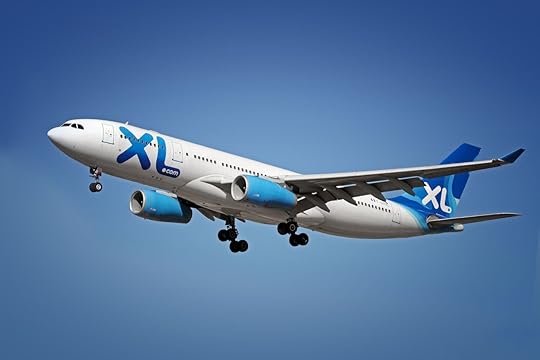
Photo: Martina Badini/Shutterstock
In general, international flights on budget airlines are a little more lenient when it comes to carry-on and personal item fees. Checked bags, however, will cost you. These are the most popular domestic budget airlines with flights to and from the US, ranked by baggage fees.
1. LEVEL
Free baggage: One personal item and one carry-on bag.
Baggage fees: Costs vary depending on when you purchase and are non-refundable. It’s $45 to $55 for the first bag ($90 to $65 for the second) when purchased at time of booking, and $55 to $73 for the first bag ($165 for the second) when purchased at the ticket counter. Every pound heavier than 50 is an extra $13, or a flat $100 surcharge for bags over 50 pounds (23 kg) on flights to and from Barcelona.
2. XL Airways
Free baggage: One personal item and one carry-on bag. One checked bag if you purchase an Eco Plus level ticket.
Baggage fees: First bag is $50 when purchased through a call center or online, $75 at the ticket counter ($81 and $115, respectively, for additional bags).
3. Norweigan Air
Free baggage: One personal item and one carry-on bag.
Baggage fees: $75 for an oversized carry-on at the gate on domestic flights, $120 on international. For checked bags purchased at the airport, the cost is $65 for direct domestic flights ($100 international). For connecting flights, checked bags purchased at the airport are $130 for a domestic connection, $165 for a domestic to international connection, and $200 for an international to international connection. Norweigan has a four-tier table to calculate baggage fees purchased at time of booking, which can be found here, that varies on departure and arrival location. Prices vary from $13 to $180.
4. Westjet
Free baggage: One personal item and one carry-on bag. First checked bag free for EconoFlex, and second checked bag free for Premium and Business.
Baggage fees: $36 for the first bag, $59 for the second, and $100 to 4118 for the third and fourth bags. Overweight bags (51 to 100 pounds) and oversized bags (63-80 inches) are $100 to $118.
5. easyJet
Free baggage: One carry-on bag. One personal item for Flexi, Upfront, and Extra Legroom customers, as well as easyJet Plus cardholders.
Baggage fees: Costs vary depending on when you purchase and are non-refundable. Price ranges from $8 to $42 for bags up to 33 pounds, and it’s only available for purchase online. For bags up to 50 pounds, the price ranges from $12 to $50 when purchased online and $60 when purchased at the ticket counter. The cost for overweight bags is $15 per 6 pounds.
6. Swoop
Free baggage: One personal item.
Baggage fees: Costs vary depending on when you purchase and are non-refundable. Carry-on bags within Canada cost $40.25 when purchased at time of booking ($46 for flights outside of Canada), $46 after booking but before check-in ($51.75 for flights outside of Canada), $51.75 during online check-in ($57.50 for flights outside of Canada), $57.50 at the ticket counter ($63.25 for flights outside of Canada), and $80.50 at the gate ($86.25 for flights outside of Canada).
Checked bags cost $46 when purchased at time of booking ($63.25 for the second and $100 for the third), $51.75 after booking but prior to check-in ($69 for second, $120 for third bags), and $57.50 at the ticket counter ($74.75 for the second and $126 for the third). 

More like this: Why charging for carry-on bags might just make flying great — or at least tolerable — agai
The post Domestic and international budget airlines, ranked by baggage fees appeared first on Matador Network.

Matador Network's Blog
- Matador Network's profile
- 6 followers



